Review of Dell Dimension E521 Desktop With X2 5600+ Processor (under construction)
Dell started offering the AMD X2 5600+ processor in December 2006 and I
was interested in giving this processor a try given my disappointing
results building Mozilla products on my Conroe E6600 system. I found a
20% off coupon for the E521 desktop on configurations over $999 so I
put together a configuration that cost a tad over $1,000 and claimed
the coupon for a total system price of $815 delivered. They indicated
that it would take 15 days to arrive but it actually arrived two days
after I ordered it. I specified ground shipment and they clearly
shipped it by air. Either that or they have a really fast truck that
can make it from Austin to New Hampshire in a day.
I ordered the E521 with the X2 5600+ processor, the DVD-RW, 2 GB of
RAM, a 320 GB hard disk and declined everything else that wasn't free
(and many things that were free). I did select the free Vista coupon
upgrade in case I decide to give it a try. I paid about $1,189 for my
HP Pavillion Conroe E6600 system back in August with a comparable
system costing somewhat less today. I added three aftermarket cards to
that system for video, audio and ethernet.
The Dimension E521 is Dell's inexpensive desktop line with AMD
processors. The E520 line offers Intel processors. Dell doesn't offer
the E6600 CPU in the E520 line so I was unable to price out a
comparable Intel solution to compare it to my new AMD system. I did
price out a similarly equipped HP Pavillion system with the E6600 CPU
and it was over $1,100. So I felt that I was getting a pretty good deal
for this system.
I was pretty happy with the HP Pavillion except for one area and that's
in building Mozilla products. The Conroe apparently performs very
poorly on this task. Our daughter started using the Pavillion as it is
a great machine for running games and she was squeezing me out of my
own office. When I was using my system, she would use her brothers
desktop (HP Pavillion X2 4400+) and we'd have arguments over desktop
time. She has a Dell Inspiron Dell 8500 but she has to run an 8 inch
desk fan to keep the system cool enough (it runs on a Pentium 4). So
the time was ripe to pick up a cheap system.
Dell has had its problem the last few years but I've always enjoyed
their products. We have another cheapie Dimension system that's
unplugged along with three Dell laptops of Pentium 3 vintage. And
everything still works.
I still use my three-year-old laptop (Compaq Presario R3000z Athlon 64
3200+ 2.0 Ghz 130 nm, 1 mb L2 Cache) for Mozilla builds but may
move everything to the new Dell desktop and I'm hoping that build times
drop significantly as I don't get a lot of time on the Presario on it
anymore. Our son uses it for college classes.
I put the Dell box into the trunk of my car and headed over to CompUSA
to pick up an nVidia 7300GT video card. My home setup is a Dell 24 inch
monitor next to a 17 inch Dell LCD display so I wanted dual output with
at least one of them DVI. I also wanted 256 MB of onboard RAM for
Vista. I went with a low-end card as most of the stuff that I do is
mundane office stuff.
One nice thing about the Dell box is that it fits into the trunk of my
car. I bought two HP desktops in 2006 and neither of those boxes fit in
my trunk. I had to do a rather awkward job of putting them into the
back seat to bring them home. HP uses this odd box size that's just
large enough in all three dimensions to annoy me. Dell also puts their
logo on the box while HP doesn't. I can see a justification for that if
you want to decrease theft.
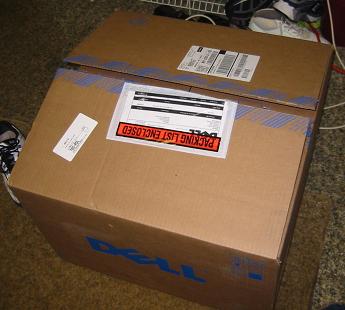
The top of the box contains a wall diagram for setting up the machine
(which I never read) and a shallow box containg a box for the keyboard
and an area for the mouse, literature and software CD-ROMs. Yes,
you heard that correctly: Dell ships the software CD-ROMs now.
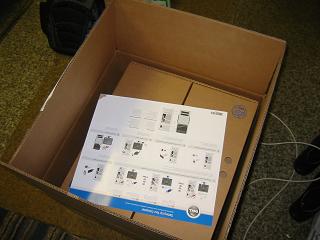
With HP, you have to make your own recovery disks which can be a real pain in the neck if you don't have a DVD burner.
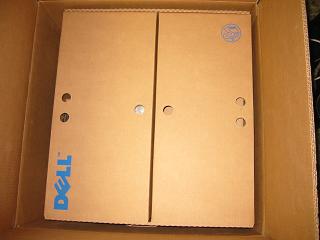
The keyboard is in the thin box to the right and is an oddly shaped
Dell design which they've had for several years. The keys have good
travel length though some might consider the keyboard bouncy. I like
Dell keyboards as they are USB devices and am happy to leave the world
of PS/2 behind.
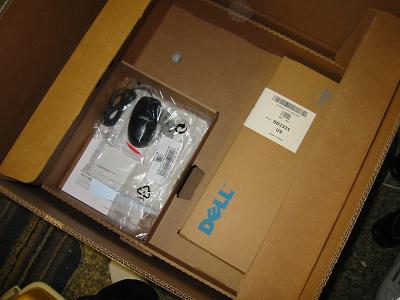
The box/compartment to the left holds the mouse, power cord, documentation and CD-ROMs.
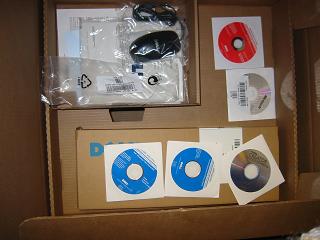
And underneath this section is the computer in two pieces of shaped
styrofoam. I already had the computer setup so it was too late to get a
picture of it in the foam. But here's a picture where you can use your
imagination.
. 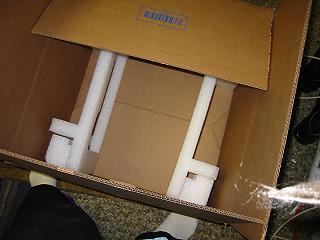
The back of the computer is pretty spartan with a ports for power,
surround sound, 4 USB 2.0, ethernet and integrated video. There are
four expansion slots in the back for PCI-X 16, PCI-X 1 and 2 PCI slots
which means that there is little room for expansion in this box.

The front of the machine is your typical PC though the two grills at the bottom remind me of car grilles.
The top contains room for two 5 1/4 inch devices and one 3 1/2 in
devices. The power switch is just above the Dell badge on the front.
There are two USB 2.0 ports and microphone and headphone jacks around the middle.
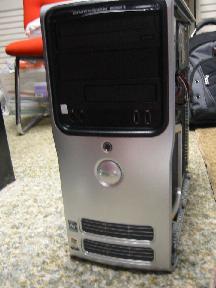
The top of the box contains the Windows Sticker and a latch. The latch
is used to remove the side panel making this one of the easiest systems
I've seen to get into the box.
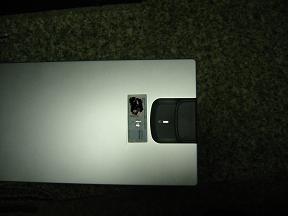
This box is smaller than the Pavillion but is fairly uncluttered. Dell
likes to add plastic to direct air and to make it easier to install and
remove things.
The wiring is cleaner than it was on my Pavillions. Note the really odd
cutout on the left. The purpose of this cutout appears to be for
ventilation. I'm not exactly sure what the airflow would be but it
could be to vent warm air from the lower 3 1/2 inch disks and//or
provide intake for the heatsink in the middle of the system. And I
suppose that it could be used as a way to grab the system when moving
it. The one drawback to the venting is that you can hear disk noise
which means that they didn't use a really quiet disk (I prefer Seagate
and Hitach drives) and that there are some pretty big airflow holes in
the system. We're not talking PowerMac or MacPro level ventilation but
it's a lot more than I'm used to in Windows boxes.
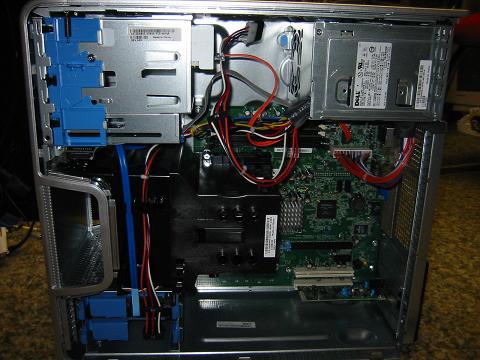
The upper right houses the power supply in your typical dull aluminum.
Dell's website lists a 305 Watt DC Power Supply which I would consider
adequate and which is one of the reasons I went with a low-end graphics
card. Good enough for a budget machine and certainly for my uses.
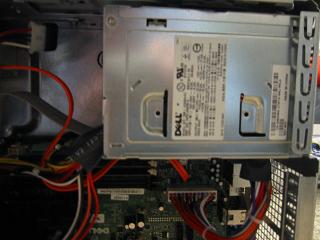
Moving down we see the right half of the motherboard. You can see the
nVidia integrated video chip, part of the four DIMM sockets with two
populated with 1 GB DDR2 SDRAM sticks at 533 Mhz. I do plan to upgrade
to 4 GB of memory at some point but I want to install Windows XP
Professional x64 edition before adding the extra memory. I generally
prefer x64 over Win32 as there are performance benefits to everyday
operations in Windows and I'll be able to access more memory.
As you can see, cabling is neat and clean and there is lots of room for airflow on the right.

Moving down we see the expansion slots. Pretty spartan here with just
the PCI Express 16 socket at the top, the PCI Express 1 socket on the
left and the two PCI sockets on the bottom. The system came with a
modem/fax PCI board which was free but I will probably remove it at
some point if I need to make room for devices to support x64 and HDTV.
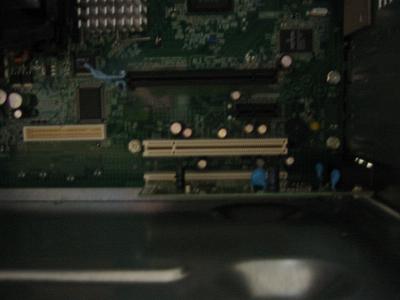
Over the left there are two 3.5 inch device bays. This system had a
free upgrade to a 320 GB disk and I took it so there's room for four
operating systems. I plan to test Windows Media Center, Vista Home
Premium, XP Pro x64 Edition and Vista Business if I can get it for free
with the x64 license purchase from Newegg.
Dell's business systems are well-known for adding plastic or metal
cartridges to make it easier to install or remove devices. Those blue
plastic pieces can slide out of their holders and they contain
everything needed for mounting. It's a lot easier than trying to screw
small blots into the racks when they're fixed inside the box.
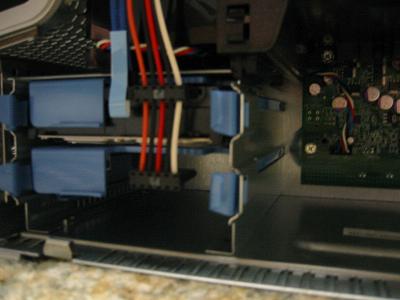
In the middle of the box, there's a big piece of black plastic covering
the CPU heat sink. Dell likes to put in ducting in their desktops which
I think is a good idea compared to just having air flow whereever it
will. The heat sink is a really huge piece of aluminum.

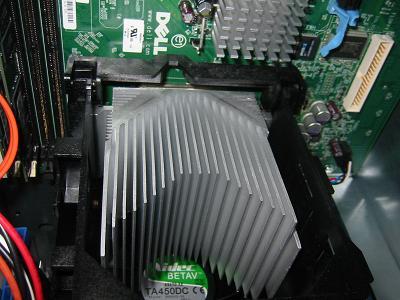
Back up to the upper-right we have area for optical/media drives and
there is additional space for a 5 1/4 device and a 3 1/2 device with
cutouts in the front. I don't do a lot of multimedia that requires
physical media so will probably leave this the way it is for now.
Setting up my desktop went fairly smoothly. I installed the nVidia 7300
GT drivers and my two wireless mouse worked. I installed Firefox,
Thunderbird, VPN for work, Tarantella, FileZilla, NVU, and Avast
Antivirus. I deinstalled Norton's security suite, Google Toolbar and
one or two other things. A few Windows updates ran and, of course,
there were many reboots in doing all of this. The machine feels
comfortably like my Conroe now with similar performance.
The main use for this computer for now will be to connect to work and
use Tarantella, Firefox and Thunderbird, and use Remote Desktop to
connect to my laptop to provide homework help to the kids. I do plan on
doing Mozilla builds on it but that will take some setup time which I
don't have right now.
In the following days, I also installed 7-Zip, iTunes and ISORecorder so that I could write iso files to CDs.
I had a chance to look around in the bios setup screen and this was one
of the nicest bios setup interfaces that I've seen. Dell usually does a
good job here with many screens and menus that are well-laid out and I
remember this from some of my older Dell systems.
I created a Windows XP Professional x64 Edition CD but couldn't get it
to boot so I went into the BIOS setup and found a very nicely laid out
set of menus to change BIOS settings. The CD-ROM was after the hard
disk so I rearranged to put the CD before the hard disk. I also noticed
that there were options for booting off the NIC, a USB floppy, a USB
Zip drive, a USB CD-ROM and a USB hard disk. It's pretty cool that they
now allow booting off a USB hard disk as it means that I could boot up
an alternate OS from a disk in a USB enclosure. I don't recall the
ability to do this with any of my HP systems. My PowerMac does have the
ability to boot off a Firewire drive.
February 10, 2007
I ran the Windows XP Pro x64 Edition installation and the first
part of the installation was fine but I suspect that there's a SATA or
PATA driver problem with the Windows installation that I've heard about
from other users. I think that there's a way to get around that problem
but I'll have to do some digging on it. Meanwhile I need a way to
change the boot timings as 2 seconds isn't enough.
I may give Dell a phone call tonight to ask them about installing x64
on the E521. Perhaps they have a page with detailed instructions on
installing Windows XP x64 Edition.
.
February 11, 2007
I retried the installation and it got past the first reboot but
generated a BSOD with an exception at IRQL_NOT_LESS_OR_EQUAL. I googled
around and found that it is generally caused by a hardware and/or
device driver problem. So this could be the SATA issue or a problem
with some other device. I'm going to try going back to the integrated
video to see if the video card is the problem. If not, then maybe it is
the SATA driver problem. If that isn't it, I'm not sure what to check
next. It appears that I'm the first to try x64 on the Dell E521 given
the lack of this configuration on the web. I know that this can't be
true as Dell has x64 drivers for this system so they must have it
running in their labs. But their tech support people don't appear to be
hooked up to their lab people.
BTW, I did speak to tech support and the guy was clueless. He thought
it was a partitioning problem but I explained to him that the
partitioning didn't matter. I guess he looked around but in the end, he
suggested calling their software people but that was a fee-based
service which I declined. I wasn't at the computer anyways. I was
hoping that Dell would have a page with information on installing x64
XP or Vista as their machines support 4 GB of RAM and Dell will even
sell you 4 GB of RAM. You just can't use it with 32-bit Windows systems.
While diddling around Dell's website for information on Windows XP
Professional x64 Edition, I did run into some interesting pages.
When I woke up in the morning, I had the idea of turning off one of the
monitors so I tried that and was able to complete the installation. So
I have a basic installation up and running and next need to get the
updated drivers from Dell and nVidia installed. I ran into one post
about nVidia driver issues on x64, maybe related to DVI and wondered if
my dual monitor system was the problem. At any rate, it was a very odd
problem and I just got lucky getting it resolved.
In the afternoon, I installed the drivers for the integrated sound,
chipset and SATA Controller from Dell's website. No ethernet access
though so I need a driver for that too. A quick look at their Drivers
and Downloads page shows that they don't have a driver download for
their onboard Ethernet so I'm stuck again. At this point I have two
options. The first is to grab the ethernet card out of the Conroe
system which doesn't run x64 anymore because our daughter is the
primary user. The second would be to find out what kind of Ethernet
device I have onboard and try to find the driver from PlanetAMD64.com.
I will try the latter first as I'd rather keep things as simple as
possible. Having spare parts around definitely does take some of the
stress out of life.
Note that I had audio after installing the sound driver and rebooting.
I had difficulty finding the sound drivers for my other three machines
and I'm still using a beta driver on my 3-year-old laptop to run
Windows x64. On the Conroe, I had to go out and buy a sound board that
came with x64 drivers. It's really, really nice when you can just
download the drivers from the hardware manufacturer's website and kudos
to Dell for putting them there.
I did download the modem/fax driver but didn't install it as I doubt
that I'm going to use the devices anytime soon. I also downloaded the
latest nVidia GeForce drivers so that I can reasonably use the 7300GT
video card and then had a look at the network controller. Running with
dual boot is really nice because I can download drivers and examine
hardware from the Windows XP MCE side while testing drivers on the x64
side. The fact that this machine boots so quickly makes this setup
phase only somewhat unpleasant.
The ethernet controller is a Broadcom 440x 10/100 Integrated Controller
so it's off to Broadcom's site to see if they have drivers available.
They list 5 driver sets and I chose the NetLink 4401 as it is the
closest in name to my integrated controller.
I installed the nVidia GeForce drivers and the Broadcom Integrated
Controller drivers and Life is Good! I got my displays back at full
native resolution and my ethernet is working. So I didn't need any
additional hardware this time around.
I installed Firefox x64, FileZIlla, Analog-X Capture, and NVU so that I
could update this webpage. Firefox x64 just absolutely flies compared
to running it on Windows XP MCE. There's just a nice speed boost in
running x64 over Win32 and it's so noticeable on this particular
system. Good job Dell and AMD!
Someone an PlanetAMD64.com requested my CPU-Z information so I took
some screen captures which you will see below. I've spent a good amount
of time this weekend on this project and it's time to work on a few
other things like schoolwork with the kids and taking a peek at taxes.
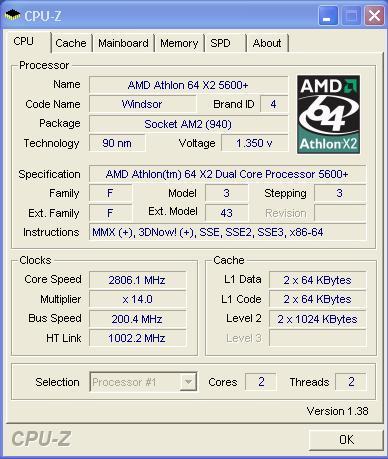
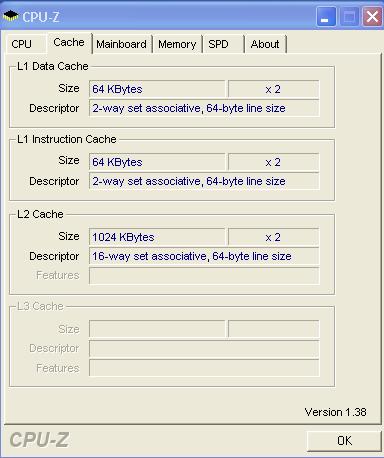
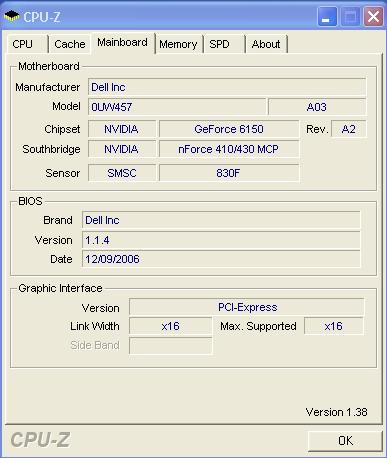

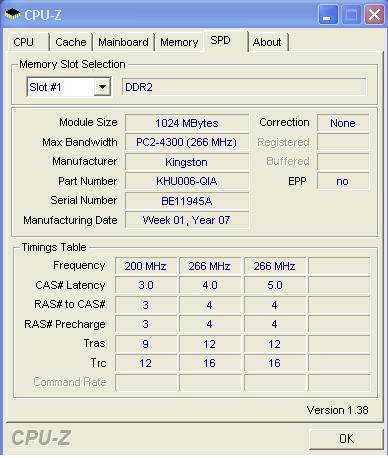
February 17, 2007
I installed a number of things to prepare for Mozilla x64 builds and to
make the machine more comfortable for work and entertainment.
- Avast Antivirus.
- VS2005 and VS2005 SP1 (just C/C++) after removing it from the Conroe.
- Windows Security Updates (151 MB worth).
- iTunes 7 (it works on x64 unlike some versions of iTunes 6.
- XEmacs Win32. I couldn't find a released x64 version though there are folks playing around with it.
- 7-Zip x64 edition.
- Virtual PC. I had to install an AMD hotfix to support hardware
virtualization. I don't have hardware VT on my laptop and didn't
install Virtual PC on the X2 4400 so this is the first time I've had to
do this.
- cygwin (GNU Tools for Windows).
- Microsoft Platform SDK.
- E-Sword.
- Java.
- Acrobat.
This machine is an absolute workhorse in the amount of work and
entertainment that it can handle at the same time. It's really amazing
how well this machine and the E6600 systems perform and I wonder what
folks that buy faster processors do with them. More speed is always
nice but at some level of performance, does it really matter? Well, I
don't have Vista up and running and maybe Vista is a performance hog so
maybe faster processors can be justified there but I'd have a hard time
spending more money for faster systems at this time.
There's a poster at PlanetAMD64 that's using a 7950GT on his E521 but
he has the X2 5000+ processor so maybe he has a little more power
available for his high-end card. Still I'm pretty surprised that
there's enough juice in this box for that graphics card. I've very
happy with a 7300GT and wouldn't think of going higher than a 7600GT.
August 26, 2007
It's been a long time since my last update and this cheap machine has
been my daily system this year and I'm very happy with it. Of course,
it's probably quite a bit cheaper now given the price war between AMD
and Intel.
I recently bought a hard drive from a local retailer, Showtime PC in
Hudson, New Hampshire, as I wanted to get away from using my external
USB 2.0 drive. The external driver uses up a USB 2.0 slot, requires a
power cord and the fan is noisy and I have to manually turn it on and
off. I think that performance is fine but maybe we can do a little
better with an internal drive. The external drive is quite a bit bigger
as the one that I bought was only 80 GB. I just wanted something for
building Mozilla products and this was a cheap way to get that done.
I opened up the E521 and looked around for a place to put the disk. I
had the choice of the upper bays or the lower bays. The lower bays
already had an extra SATA power connector in just the right spot so I
put the disk in the plastic sleeve and slid it in. It fits rather
snugly and of course it doesn't work as there weren't any spare data
connectors in the machine so I just left the disk inside. This is the
first time that I've done anything with SATA drives so I had a look on
the web to learn about the different standard. I also had a look at the
connector for the system drive in the E521 and the connector for the
DVD drive. They both plugged into small ports on the motherboard. I saw
that there were two additional ports on the motherboard and it appears
that I just need to buy a cable to hook from the motherboard to the
disk and I should be in business.
I did order and eventually received the Windows Vista Home Premium disk
from either Dell or Microsoft. I never got around to installing it
though. I've heard so many negative things about Vista and personally
don't feel the need to install it as I'm perfectly happy with Windowx
XP Media Center and Windows XP Professional x64 Edition.
The systems has accumulated a little bit of dust and I'll need to get a
special vacuum cleaner that we have to blow out the dust. Dust and dirt
can take a toll on performance for computer systems.
I should post a note when I have the second hard-drive up and running.
For a budget machine, it certainly gets the job done. I'm hoping that I
won't run into any power issues with the additional drive. If I do,
then the disk goes on one of the kids' machines which have bigger power
supplies.
.
August 29, 2007
The right-angle SATA cable arrived. It was an 18 inch cable with a very
short right-angle connector. I saw another right-angle connecter that
probably wouldn't fit so be careful if you order a cable for an
additional disk drive. The 18 inch cable just fit. I would have
preferred something like 33 inches but I didn't see one for sale. I
ordered two of these in case I need one for another device or system.
The disk is in and is nice and speedy. Perhaps the shorter cable
improves performance.
My next potential upgrade for this machine is getting up to 4 GB of
RAM. It's pretty hard to justify right now so I'll only upgrade if the
memory is really, really cheap. At the moment, the Crucial.com
recommended upgrade is under $100 to get to 4 GB of RAM with the faster
memory. The slower memory is dirt-cheap. I can't really think of
anything that I need to add right now.
December 27, 2007
.I
was looking for a pickup in performance and more storage space for the
Dell E521 so I finally got around to picking up another 2 GB of RAM. I
also wanted more in-system storage so I picked up a Seagate 750 GB
disk. At the moment, I'm using an external drive to store university
course videos but it's a noisy solution as it has a fan that makes a
little noise.
I bought Super Talent Heat Spreader PC4200 memory
for about $42 per stick. The reason for the high cost was that I went
to a local retailer for the part. The memory went in easily and there's
a nice performance improvement when running Windows XP Pro x64 Edition.
Basically more files are cached which means program startup and file
operations run faster as they are cached. I don't have to worry about
running out of memory either.
I got the disk and then started
looking up the specs and found that that model used 50% more power than
previous generations and generated a lot of heat. The Dell E521 3.5
inch disk bays don't have space for a hard drive cooler so I returned
the disk and did some research on disk drives in general. I found that
those with lower capacity tend to use less power and put out less heat.
I may wind up with another 160 GB drive in the system.
The
system is my daily machine at home and it gets the job done quite
nicely. There's a lot out there that's tempting and Penryn will
certainly be interesting but, at the moment, I can't really justify a
new system as my daily driver.
One other thing: at this point, I
would not recommend buying a system with AMD chips given the murky
outlook on an upgrade path. Who knows when they will get their Phenom
issues settled. At the moment, upgrades are in extreme doubt.
.
January 4, 2007
I installed the Intel C Compiler, version 10.1 on a free-trial basis to
see if it is usable for building Firefox and Thunderbird. The
installation went smoothly and I'm impressed with Intel's code
generation quality.
I'm considering a 160 GB SATA drive to replace the 80 GB secondary on
the E521 and am thinking of a Seagate model. It seems that the smaller
Seagate drives are pretty good on power consumption. Another option
would be to buy a new system from Dell with a Penryn chip in it and
then put this machine in the living room for general-purpose use. We're
using a Dell Vostro that I borrowed from my son's apartment in the
living room as the PowerMac G5 is down for cleaning.
I can't complain about the performance of the Dell E521 but I want to
experiment with SSSE3 instructions and AMD doesn't support those
instructions in any of their chips.
Last Updated January 4, 2007.
All trademarks used are property of their respective owners.




